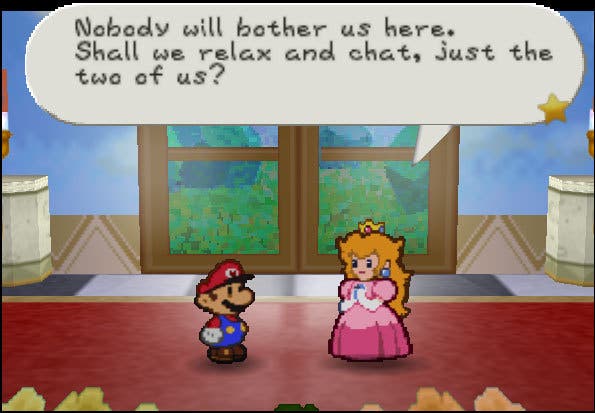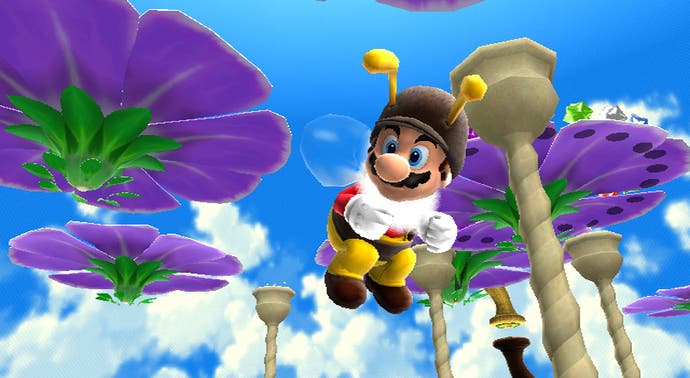The History of Mario
Twenty-five years of plumbing the heights.
While the free-roaming gameplay was retained, the game tasked our plumbing pal with the job of cleaning up the tropical resort of Isle Delfino. A pesky Mario impostor has covered the pristine retreat in muck and pollution, so Mario uses the FLUDD backpack to squirt everything back to normal again. Much like Luigi's Mansion, the game isn't entirely awful - it was just a far cry from what fans were expecting, and blighted by uncharacteristically clumsy gameplay to boot. The water-squirting basis of the game came in for particular criticism, since it all but replaced the beloved tropes of Mario games past. Perhaps after Luigi's Mansion, we were just tired of Mario games that were driven by gimmicky sucking-blowing backpacks rather than the characters themselves. Sales were solid, and review scores were high - our very own Bramwell commenting "The best game ever? No, but you'd be a fool not to buy it" - but its stature has diminished considerably over the intervening years.
Meanwhile, over on the handheld side of the aisle where Nintendo continued to dominate, things weren't so bleak. As well as multiple ports, remakes and compilations of NES and SNES classics, the Mario RPG strand continued to be lovely and special in the 2003 GBA game Mario & Luigi: Superstar Saga and its 2005 DS sequel, Mario & Luigi: Partners in Time. Both were full to the brim with the charm and whimsy that many felt was ebbing away from the character's console efforts. And, should you need any more evidence of the Groundhog Day existence Nintendo had slipped into by this point, Mario's final narrative excursion on the Gamecube was another finely crafted role-playing adventure that arrived just as gamers were abandoning the platform. And it's a real shame, since Paper Mario: The Thousand-Year Door bristled with fresh ideas and inventive gameplay elements that had been absent from Sunshine.

Mario Kart: Double Dash buoyed our spirits for a while, striking a fine balance between classic gameplay and new features despite featuring Waluigi, but with the Gamecube struggling to keep pace with the Xbox, let alone catch up with the PS2, things soon settled into much the same moribund pattern that blighted the N64. More Mario Party games (the series made it up to a seventh entry on this hardware, plus an arcade cabinet spin-off), more sports games bearing the Mario brand (such as Mario Power Tennis, Mario Superstar Baseball and Mario Super Strikers), plus a smattering of cameos in other Nintendo offerings, including an unlikely appearance, albeit in toy form, during Metal Gear Solid: The Twin Snakes. Many of these outings were perfectly pleasant, but when held up against the creative peaks of the past, it was disheartening for fans to see the character stuck in a rut.
Thankfully, in true Jeremy Irons style, a reversal of fortune was on the horizon...
Notable Oddity: Mario's genre-hopping may have gifted us with such classics as Mario Kart and Paper Mario, but there have been some weird attempts to expand his appeal as well. Take Dance Dance Revolution: Mario Edition, for instance, in which rhythmically gifted Mario fans could flail about on a dance mat to the sound of remixed tracks drawn from Mario's engorged back catalogue. And if you didn't fancy dancing along to Jump! Jump! Jump! - the music from the second overworld in Super Mario Bros 3 - you could always embarrass yourself to Mario-tweaked versions of classical pieces from Elgar, Mozart and Strauss.
2006 to present - The Wii years

Sometimes you have to go backwards in order to move forwards, and so it was that Nintendo's decision to opt out of the increasingly expensive console race between Sony and Microsoft found them getting their groove back (if not their scheduling). For the first time since the heyday of the SNES, Nintendo is sitting at the top of the home console heap with both the Wii and DS flying out of shops like shop-phobic flies.
Nothing illustrates this shift in fortune, and the change in perspective that brought it about, more than New Super Mario Bros which danced merrily onto the DS in Spring 2006. The first traditional 2D Mario platform game since Super Mario Land 2 on the GameBoy, it showcased a Nintendo that was embracing its past and putting faith in old fashioned gameplay to win the day over gimmicks. It worked. A breath of fresh air, elegantly poised between the wisdom of age and the thrill of innovation, New Super Mario Bros immediately reminded players of why they'd grown attached this podgy plumber in the first place.

Then along came the Wii, and with it the ability to download and play the untouched originals that started it all via the Virtual Console. OK, the prices are wonky and the old PAL conversion problem irritates visual purists, but as a symbol of Nintendo's past and future in cheerful harmony it's hard to beat.
This time around, they got the timing right. Super Paper Mario arrived with millions of Wii owners ready to enjoy its quirky joy, finally breaking the curse that left previous Mario RPGs dangling in the void, while Super Mario Galaxy at last gives us the 3D sequel we've been waiting for since 1996. With Super Smash Bros Melee and Mario Kart Wii to come in 2008, it's not hard to imagine the silly old Italian stereotype being around for another quarter century. When we'll probably control him in hologram form. Using our mind.
